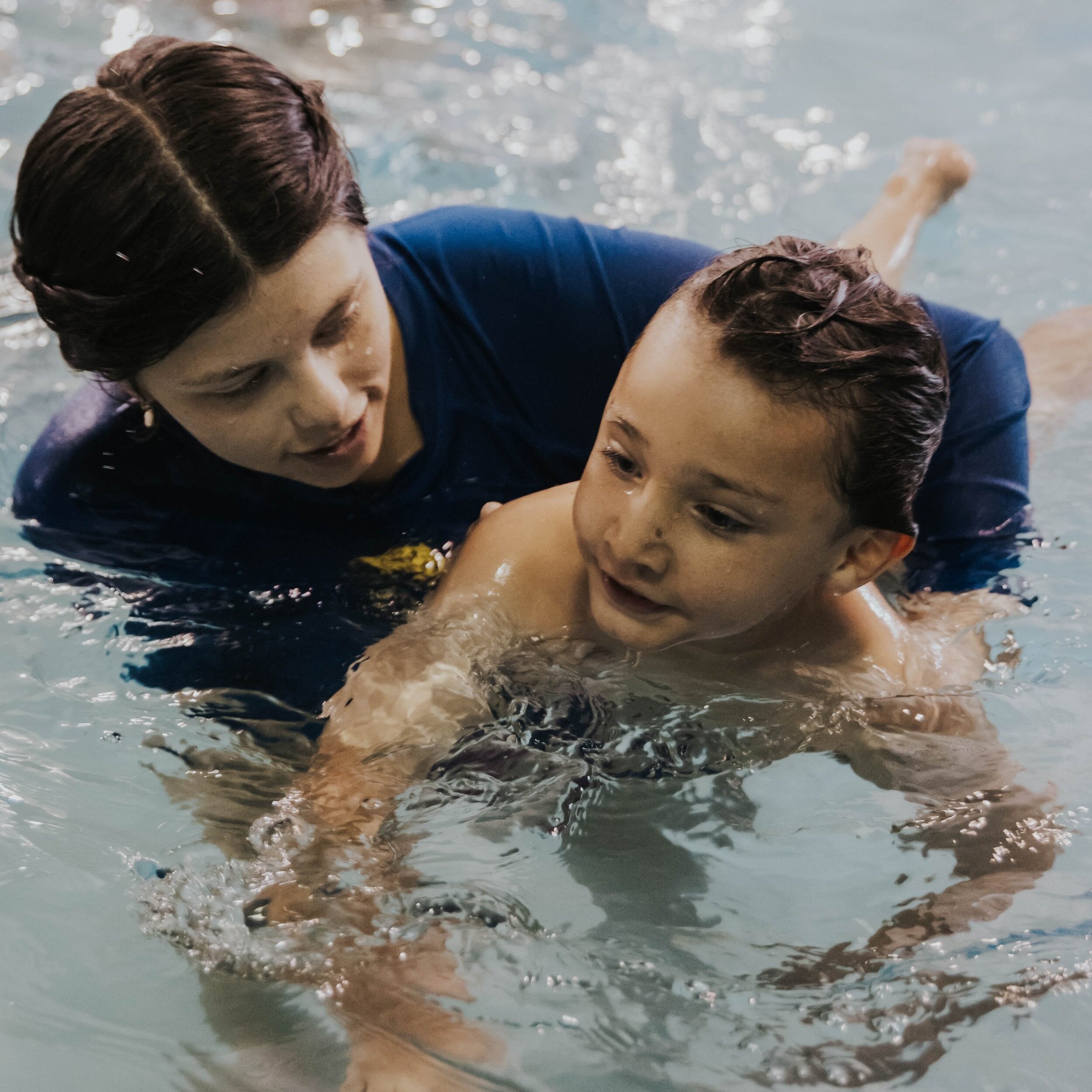Water Safety & Survival
Our Safety-First Lesson Philosophy
At Little Fins Swim School, safety isn’t just part of our lessons — it’s the foundation of everything we do.
Every class, from our Aqua Babies to our advanced one-on-one lessons, is built on the principle that confidence begins with safety. Our certified instructors teach children to respect the water, understand boundaries, and develop essential survival skills before strokes or speed.
We follow a “Safety First, Skills Second” progression model that focuses on:
Breath Control and Buoyancy: Teaching children how to safely hold their breath, float, and find the surface.
Self-Rescue Skills: Equipping swimmers to roll, float, and reach safety if they fall into water unexpectedly.
Comfort Through Consistency: Creating calm, structured lessons in warm water to promote trust and learning.
Awareness and Supervision: Reinforcing the importance of asking permission, following rules, and swimming with a watchful adult present.
Our goal is to ensure that every swimmer — and every parent — leaves our pool with more than swim skills. We want them to leave with freedom from fear and the knowledge to stay safe in and around water.
Safety first. Skills for life. Awareness for the world.
Save this FREE Water Watcher card to take with you to all water activities.
Tip of the Month
Staying Safe Around Water
We love when the community reaches out to share safety tips with us. Emma Johnson from Sieben Polk wrote in and asked if we would share their Child Safety Tips.
Here are 3 tips their shared in their Water Safety Tips. Click here to read all 8 tips!
Never take your eyes off your child when they are in the water.
Empty your backyard pool when not in use.
Designate someone to watch the children during parties and group events.
Swimsuit Color Matters!
While most people want to look good in a swim suit we encourage you to choose the color carefully. Elsa and Frozen swimsuits are very popular, but the color is not ideal for safety reasons. “The light blues, teal and white colors in many popular character swim suits make finding a child under water very difficult” says Haley Armstrong, Little Fins GM, “Adults and kids should think carefully about safety when choosing suit colors.”
Choose bright colors.
Avoid light blue, gray, and green as they can blend with the water.
The color of swimsuit can impact how visible you are in the water, which is critical in preventing drowning.
Open Water Safety Tips
Open Water can be extremely dangerous. Here are a few tips to keep you safe.
Swim in a designated swimming area.
Know the weather and water conditions.
Never swim alone.
Choose the right equipment.
Wear a USCG-approved life vest.
Outdoor Water Safety Tips
Outdoor water can be dangerous. These tips will help you to be prepared.
Learn to swim.
Swim in designed areas and by a lifeguard.
Wear a life jacket.
Know your limits.
Obey all hazard signs.
Beware of drop-ofs into deep water.
Bath Time Tips
Bath time safety is extremely important. Know how to keep your child safe in the tub.
Always keep your hand on your child.
Have their towel and supplies within reach.
Check the water temperature.
Never leave child alone in the bath no matter what.
A child can drown in as little as 1-2 inches of water.
Even though the lakes and ponds are thawed, they are still dangerously cold.
Spring Time Water Safety!
Lakes and ponds will begin to thaw but the water temperature is dangerously cold. Be alert when outside near water.
Some may travel for Spring Break, always stay observant near pools.
Be prepared to navigate emergencies.
Prevent water accidents in the home.
Always supervise children in and around water in the home.
Always close washing machines, toilets, and in-home spas when not in use.
Always empty water from sinks, coolers, and containers.
Always supervise children in the bathroom.
Learn how to perform CPR.
Drownings can happen in as little as 1 inch of water.
Swimming accidents can happen, even in the cold months.
Wading onto ice that you assume is frozen to a safe thickness can be dangerous. Be sure you know.
4 Steps to Prevents an winter water accident:
Stay away from unfamiliar ice. The thickness of ice can change throughout the season, and from year-to-year.
Prioritize swim lessons, even during the cold months.
Never leave your child unattended in or around a open hot tub.
Be alert when sledding. Snow can cover rivers and creeks, so plan a route that avoids water sources, even if they seem frozen over.
Prevent swimming accidents with these 5 tips!
Drowning is the leading cause of accidental death in children under the age of 4 years old. It is the 2nd leading cause of death in children under the age of 14.
Teaching your child these simple tips could save their life one day:
1. Step or jump into water that is over your head and return to the surface. Help your child practice rising/kicking to the surface of the water, but ONLY when you are there to supervise.
2. Tread water for one minute. Treading water for a longer amount of time will help your child become a stronger swimmer and be less afraid in deep water. That confidence and strength can be life-saving in an emergency.
3. Swim 25 yards to the exit of the pool.
4. Practice exiting the pool without using a ladder.
5. Never swim alone. Even children who are strong swimmers should never be left unsupervised.
Did you know?…
Never let your child swim alone or without a water watcher.
Supervise your child whenever they are near water.
Inexperienced swimmers should always wear a life jacket.
Teach your child to never help another struggling swimmer but to always get a trusted adult for help.
Bath-Time Safety Tips
Never leave a child unattended in the tub. Accidents happen quickly and may be fatal.
Always supervise babies, toddlers and children under five years in the bath. Never leave older children or siblings to supervise. They don’t have the skills to see and react in an emergency situation
Get everything ready in advance so you can stay with your child for bath time – towel, face washer, cotton wool, clean nappy and clean clothes.
Let the water out as soon as bath time is over. About 5-10 minutes is long enough for a baby bath.
Are puddle jumpers safe?
Puddle Jumpers are a less bulky floatation Aid, and are U.S. Coast Guard Approved.
Puddle jumpers are U.S. Coast Guard-approved flotation devices that are less bulky than a life jacket but safer than inflatable swim devices. These Type III devices are considered a flotation aid. Flotation aids are more appropriate for preschoolers with better body control, but do not turn a wearer face-up in the water like a life jacket will.
If you have a preschooler between 30-50 pounds, you may be interested in trying puddle jumpers. These Type III flotation aids combine elements of a swim aid and a safety vest. Look for a buckle that snaps in the back, which can help keep a child from removing the vest on their own. And, be sure to check the product packaging to ensure the puddle jumper of your choice is a U.S. Coast Guard approved device.
Drowning Quick Facts: Stay In The Know
In the U.S. drowning takes an average of 3,500-4,000 lives per year. That is an average of 10 fatal drownings per day.
Drowning is the leading cause of unintentional injury related death for children ages 1-4. Drowning remains in the top 5 causes of unintentional injury related death from birth to 54 years old.
In addition to fatal drownings, the Centers for Disease Control and Prevention (CDC) estimated that in 2016 an additional 9,000+ victims were seen at U.S. Emergency Departments for a non-fatal submersion injury.
23% of child drownings happen during a family gathering near a pool.
Lack of barriers around water contribute to a majority of drowning deaths.
Learning to swim can reduce the risk of drowning by 88% for 1-4 year olds who take formal swim lessons.
No one is drown-proof and drowning doesn’t discriminate.
Drug and alcohol use can be large contributing variables to drowning risk.
Drowning is the cause of death for most boating fatalities.
It is estimated that for every fatal drowning victim, another 5 to 10 victims receives hospital related care for non-fatal drowning injuries.
Drowning is fast and silent. It can happen in as little as 20-60 seconds. Drowning doesn’t always look like we would expect.
We believe that to prevent drowning, a multitude of safety strategies should be in place to reduce risk. The NDPA utilizes an approach referred to as “Layers of Protection”.
Always Watching…
Choose a responsible adult to be the “water Watcher” when children are swimming.
Watch kids when they are in or around water. Keep young children, and weak swimmers within arm’s reach of an adult. Make sure more experienced swimmers are with a partner every time.
Choose a Water Watcher. When there are several adults present, choose one to be responsible for watching children in or near the water for a certain period of time, such as 15 minutes. After 15 minutes, select another adult to be the Water Watcher.
Winter Water Safety is just as important as Summer Safety.
Here are 5 Tips from our friends at The Zac Foundation:
Stay off of unfamiliar ice.
Have an emergency plan.
Prioritize swim lessons, even during cold weather months.
Wear proper clothing for cold water and weather.
Never leave your child in a hot tub unattended.
At Home Safety
Tricks & Tips
Bath Time Practice
When your child is having bath time practice bubbles! Use a straw or pretend to blow out birthday candles in the tub. When they come in for lessons their confidence under water will progress a faster. It's always fun to have them go under to look for toys or use their imagination to "see" what's under the "sea."
Practice Makes Perfect!
When you are giving your child a bath at home, have them practice their float on their back in the bathtub. If they are learning the swim-float-swim method (aka tap-tap-turns), they can also roll over, blow their bubbles, and flip back on to their back in the bath. The more confident they are at home the better they will do at swim lessons! Your child's instructor will LOVE to see what you've been working on in the bathtub.
Sing songs, count, and make it a game! You can assist their float by placing your hand under their head while they are floating in the bath!
Important Water Safety Statistics
From the CDC:
In the United States:
More children ages 1–4 die from drowning than any other cause of death.
For children ages 5–14, drowning is the second leading cause of unintentional injury death after motor vehicle crashes.
How Many Can You Perform?
While 80% of Americans say they can swim, only 54% can swim well enough to save themselves! This means they can perform the 5 basic safety skills:
Floating or treading for 1 minute.
Jumping into deep water and coming up for air.
Becoming disoriented in the water and then finding a way out.
Getting out of a pool without a ladder (we call this Exit Strategy).
Swimming one pool length without stopping.








































